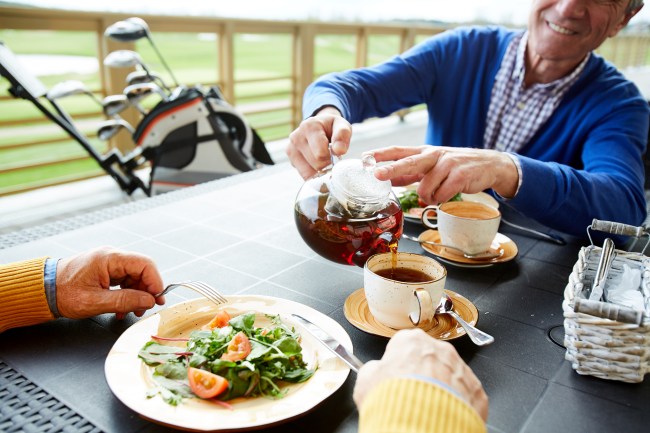
iStockphoto
Picture this: it’s 7:20 on a Sunday morning. You jog to the first tee in a serpentine pattern, your clubs clanking and banging as you try to apply sunscreen and sip your coffee and grab a few tees and a scorecard pencil. A headache of gathering pain is rolling in from the back of your brain to the front, like a bank of thunder clouds. Your shirt is tucked into your fly and a dark constellation of urine circles is connecting down your pant leg. You look, and feel, like a junkie. The front nine awaits, as does the rest of your group, chuckling as they see the village idiot hustling out to join them. You haven’t warmed up and you’re still drunk. You have no idea how fast the greens are. The odds of you hitting a decent ball off the first tee are smaller than the tax bracket your parents occupy.
Shank. Breakfast ball. Hosel rocket. FORE 18 GREEN! Brunch ball. Duck hook. I’ll just drop up with you guys.
By the 9th hole, you’ve carded three “DNF” holes and you’re now playing an orange Top Flite XL 3000 with “BIG FRANK” monogrammed on the side (you’re not Frank, not even close). You found the ball in a pocket you didn’t know existed in your bag. You threw up in a waste bunker on 4. You’re holding on for dear life and somehow, your friends decided to play the rounds of their lives while you scalp the fairways around them, chunk after chunk after chunk. This might be your last round in the state of New Jersey. The governor might ban you. You pull up eBay on your phone to see what price you might get for your clubs.
And then… you round a bend in the cart path and a chorus of angels hits that perfect note. With its shingled sides and welcoming green awning; with its display of rolling hot dogs, waiting to be plucked and tucked into a bun and dressed with relish and sauerkraut and ketchup and mustard; with its ornery old-timer, as much a part of the course as any green or false front, who lives and breathes college football and tips his tattooed forearms for generous pours with a wink; with its decent bathroom, its temporary sanctuary, its liquid courage, the halfway house is your island in a storm.
Some people call them comfort stations. Links Magazine ran a spread on the five best in the world. I’d throw Hawaii’s Kukio in there. Never seen anything like it. Refrigerated drawers full of nips of orange-flavored grey goose that pairs perfectly with a fresh-squeezed cup of OJ, frozen chocolate-covered bananas dipped in walnuts, the best PB & J station I’ve ever seen… and there are two of them. I’m also a sucker for the low-key charm of National’s halfway house. I’ve heard stories of members getting caught in the rain around the ninth hole and bunkering down for marathon card games in the bare-bones hut, losing track of time and place with the help of a few dozen cocktails.
But the term “halfway house” takes on an entirely different meaning once you step from the gleaming world of elite private golf courses and into the harsh world of criminal justice reform. On this side of the coin, a halfway house is a place where released inmates can go to learn skills necessary to reintegrate into society. It can also serve as a rehabilitation center for people recovering from addiction. Indeed, these halfway houses are the last place you’d want to find the convenience of a refrigerated drawer of help-yourself liquor.
And yet, in many ways, they serve a similar purpose. Are they not both meant to help a beleaguered soul regain his footing and send him on his way? Does not the forlorn character from our earlier tale share a need for comfort, guidance, structure, and encouragement with his rehabilitated inmate counterpart? Are not we all, at some point in our lives, in need of a sheltered place to take a load off, get out of the sun, steel our resolve, and brush up our LinkedIn profile/wedges?
Don’t we all deserve a second chance at the back nine of life?
Whether you’re a convicted felon just looking for a steady 9-to-5 or a 16-handicap just looking for a steady string of bogies, we’re all grateful for the halfway houses of our lives. Here’s to turning it around.